#klingon cardassian alliance
Explore tagged Tumblr posts
Text
So one of my favorite things the mirror universe does is put characters in positions their prime selves would hate.
Spock is forced into a leadership position neither version of him would particularly want, though his role as a revolutionary does echo his prime self founding the Unficationist movement later in life.
Smiley, similarly, has even more responsibilities thrust on him than the already overworked prime O’Brien. You just KNOW he’s still having to maintain that bloody space station while also leading the revolution and having to shut down Bashir’s stupid gung ho ideas (thank the prophets for Tuvok) and keep him from shooting their own guys (again)
Federation values peace first Georgiou is reflected by a brutal Emperor who later takes delight in working for Section 31, who are practically the Federation’s “Wolf Inside” to steal a phrase
Freedom fighter Kira is reflected by a slavering dictator who takes a perverse delight in causing cruelty and tries to garner validation while doing it in a manner not at all dissimilar to Dukat.
Tilly is TERRIFIED of Killy and she’s ever really met her.
But what if, for another way to show the mirror universe taking familiar faces and having things go catastrophically wrong? Before anti fascist revolution takes hold and hopefully steers things to a better path, that is.
The wrong people, in the wrong places. The worst people in positions of power.
The novels already had a kernel of this idea with Supreme Legate Dukat as leader of the Cardassian people, and without any Dominion deals to make it happen. Let’s expand on that.
First Minister to Bajor and second most powerful Bajoran after Intendant Kira? Why, Kai Winn of course. She may even take the role of Intendant after Kira’s fall from grace.
Leader of the Klingon people? Many stories give this job to Regent Worf, but I say, what if he is only a regional governor of a section of space under his rule? The throne holder back on Qo’Nos? The man with the cunning to place himself on top? No doubt with Cardassian help for “the good of the Alliance” of course. A man with no respect for Klingon tradition?
I submit to you, Emperor Duras.
Let’s go a century back, to. The Terran Empire would REWARD Kodos for his “original thinking”. A man with such power and prestige that Kirk can’t risk his career to kill him, but he would like to.
And let’s not forget Garth of Izar. Genocide is horrifyingly normal in the Imperial Starfleet, he’s NOT getting mental health treatment. He’s probably still a beloved war hero, maybe even a powerful admiral. A potential contender for the Emperor’s throne after the loss of Georgiou.
Sometimes the darkest reflections are all too familiar.
#star trek#mirror universe#mirror spock#spock#miles o'brien#smiley#kira nerys#intendant Kira#phillipa georgiou#emperor georgiou#Garth of izar#duras#winn adami#kodos#kodos the executioner#mirror kirk#james t kirk#regent worf#worf#klingon cardassian alliance#klingons#cardassians#gul dukat#bajoran#terran empire
55 notes
·
View notes
Text
Hello! And welcome to my The Pitt Star Trek AU :) This is Part Two.
In this part I shall try to figure out the Star Trek Universe races for all the main (and maybe some important background) characters, as well as their ranks. As a reminder – The Pitt is officially known as USS Pittsburg. It’s an old boat, that should probably be decommissioned, but uh. Captain Robby served on her under Captain Adamson and he’s not ready to let her go yet. The Pitt is falling apart a little, but her crew patches her up enough to let her pass tests and examinations at the spacedocs.
Also, someone in the admiralty must dislike Robby, because they often send The Pitt on shitty assignments and all the damage sustained during those assignments doesn’t help her condition either.
Anyway. Let’s get to the chase.
Captain Michael "Robby" Robinavitch is a human in my mind. I’ll gladly accept constructive crit on that, though. As I will for all the other characters ;) Bring it!
Commander Heather Collins formerly a science officer, now the ship’s 2IC, is Bajoran.
Lt. Commander Frank Langdon navigator and pilot, as well as the ships 3IC (as suggested by lovely @magnetic-rose , thank you) is... well that one I can’t quite decide. He could be human, I guess. Although I’m tempted to give him some sort of weird Illyrian or El-Aurian provenance. IDK.
Lt. Commander Yolanda Garcia (should have a different name) is IMO, of one of the more aggressive races (or part of that race, actually). IDK, half-Klingon, half-Romulan, half-Cardassian even... Oh! I know! She’s half-Cardassian, half-Bajoran, raised on Bajor, but her Cardassian genes make her act up. I had her pegged as the ships second pilot, but now (after the 4th episode) I think she’d be better suited as the tactical officer.
Doctor Lieutenant Samira Mohan the ship's very capable doctor, strikes me as Vulcan.
Kiara Alfaro is a civilian counselor and a human.
Lieutenant Cassie McKay the Chief Engineer of The Pitt I’d rather see as human as well...
Petty Officer 1st Class Mateo Diaz(?) ...but her assistant could be, say, Orion. Or. It could be the other way around. Or, some other race. Let me remind you, I’ll appreciate any (well, most) suggestions.
Lieutenant Melissa King I'm-- Yeah, I don’t think I’ll want to change that one, though. ;) Mel, the communications officer feels like Trill to me. I’m just not sure what would be the Symbiont’s name, and what would be the name of the before-the-Symbiosis Trill. But I’ll figure it out.
Ensign Trinity Santos she was slated as the tactical officer, but with Garcia stepping up to that position (it makes more sense to not have a fresh-out-of-Academy Ensign as weapons specialist), Santos would be Garcia’s protege coming onboard. I thought she could be a Romulan (depending on the time period where my story would take place; if I’m not mistaken Romulans were in alliance with Starfleet at some point? I may be wrong, of course, so feel free to correct me), but with Garcia advancing to the main cast, Santos could be Cardassian, or Cardassian-Bajoran too.
Master Chief Petty Officer Dana Evans the supply officer could be human. Or Lanthanite, I guess. I love that sense of her being something more, some larger presence onboard The Pitt, extending way beyond. Other than her being a thousand years old, she might instead be a Betazoid.
Cadet Dennis Whitaker and Cadet Victoria Javadi feel like humans. For now, at least. Oh, Javadi’s parents (as—again—suggested by @magnetic-rose) are both Admirals.
All the nurses, Perlah, Princess, Jesse, Donnie, IDEK, should also be humans, I think. Because, after all, The Pitt hails from Earth. Unless she doesn’t.
I’m beginning to have the barest bones of the fic plot, so watch this space for updates. :)
#es talks about writing#the pitt star trek au#the pitt#im not tagging all the characters too many of them#the pitt fanfic#the pitt 2025
11 notes
·
View notes
Text
The original "Mirror, Mirror" episode of TOS is revealing for what it says about the priorities of the Federation and Starfleet, but the return to the Mirror Universe in STAR TREK: DEEP SPACE NINE, ENTERPRISE, and DISCOVERY is mostly indicative of the intense hypocrisy (and acute moral failings) of modern STAR TREK writers in addressing the conceptual structures in which the franchise operates.
DEEP SPACE NINE's Mirror Universe episodes are predicated on the idea that mirror-Spock did eventually succeed in reforming the Terran Empire, but it produced a worse result: The Alpha Quadrant was conquered and the former worlds of the Empire enslaved by the Klingon-Cardassian Alliance. The writers of DS9 have been explicit about how they intended this to be interpreted: According to Michael Piller, who is the credited co-writer of the script, in Ira Steven Behr's words, mirror-Spock "actually screwed things up" by bringing about "a much more gentle empire that was conquered and taken over by the Klingons, the Cardassians and others." (This is per Captains' Logs Supplemental: The Unauthorized Guide to the New Trek Voyages, as quoted in the Memory Alpha page for "Crossover.")
The idea of showing that the TOS characters were not infallible or always correct is by no means unreasonable; it's certainly true that throughout TOS, Kirk often attempts to enact dramatic, sweeping changes in other societies based on snap judgments, and it's fair to suppose that some of those decisions didn't turn out well (which is something the DC STAR TREK comic examined at several points). However, it's revealing, and dismaying, that the one DS9 chose to pursue is "Mirror, Mirror" rather than, for example, "A Taste of Armageddon," "The Apple," or "Return of the Archons." After all, what could be more emblematic of the liberal values of STAR TREK than the Kissingerian argument that fascism is justifiable where the alternative is disorder and instability? I don't hyperbolize when I say that this is the most morally indefensible position presented in DS9, although it's also sadly consistent with the franchise's political position overall.
To make matters worse, Robert Hewitt Wolfe, who contributed to the script, later asserted (in the Deep Space Nine Companion):
Empires aren't usually brutal unless there's a reason. There are usually external or internal pressures that cause them to be that way. So I just thought that if the parallel Earth was that brutal, there had to be a reason. And the reason was that the barbarians (the Klingons and the Cardassians) were at the gate.
This statement is so abhorrent I don't even know where to begin, and it makes an argument much darker than anything in "Mirror, Mirror," whose depiction of the Terran Empire is singularly horrifying, leavened only by the campy cartoonishness of its presentation.
The storyline of the ENTERPRISE Mirror Universe episodes, the two-part "In a Mirror, Darkly," is clearly shaped by Doylist (real-world) priorities — specifically, to nostalgically revisit the aesthetic of TOS — and the admittedly amusing spectacle of the regular cast playing comically evil variations of their Pollyanna-ish characters. It mercifully doesn't take Wolfe's bait about the rationale for the Empire, instead indicating that the divergence between the Prime and Mirror Universes dates back to before the events of FIRST CONTACT. However, "In a Mirror, Darkly, Part II" ends up strongly implying that the main reason the Terran Empire of Kirk's time is so similar to the Prime Universe Starfleet is that the Empire has captured (and presumably eventually reverse-engineered) a time- and dimension-displaced 23rd century Starfleet vessel, the doomed Defiant from the TOS episode "The Tholian Web." DISCOVERY muddies the waters on this point, but the ENTERPRISE episodes tend to undermine the idea that the Terran Empire is simply a different version of the Federation, instead implying that its technology and knowledge is stolen from its future "good" counterpart.
Then we have DISCOVERY's Mirror Universe episodes. Hoo boy. DISCOVERY acknowledges the ENTERPRISE storyline without really answering the questions it raises beyond indicating that knowledge of the captured Prime Universe ship is a closely guarded secret ("Vaulting Ambition"). However, DISCOVERY makes a series of extremely troubling attempts to argue that the moral failings of the Mirror Universe reflect differences in the structure of that universe (for instance, the utterly absurd assertion that the Mirror Universe is literally darker than the Prime Universe, rendering Terrans unusually photosensitive) and even the biology of its inhabitants. "Die Trying" indicates that by the 32nd century, Starfleet believes that "a chimeric strain on the subatomic level in the Terran stem cell" gives Terrans a biological inclination toward duplicity. Yikes! This is a ghastly eugenicist argument, if anything even more repellent than Wolfe's apologia for tyranny: Some people are just biologically predisposed to be evil! Thanks, I hate it!
Again, this is much worse, and much more facile, than "Mirror, Mirror." In "Mirror, Mirror," the Mirror Universe and its brutal Terran Empire serve as essentially a moral bellwether for the Federation and the familiar STAR TREK characters. Its condemnation of fascism is not deep ("the illogic of waste"), but perhaps the most valuable point it makes is that the (relative) goodness of the Federation and Starfleet is not a state of being, but rather the product of an ongoing series of moral choices. This is the other part of Kirk's argument to mirror-Spock: When mirror-Spock remarks, "One man cannot summon the future," Kirk immediately retorts, "But one man can change the present."
DISCOVERY takes the opposite position: The evils of the Mirror Universe are intrinsic and immutable, and its resemblance to the Prime Universe is largely a coincidence that is rapidly diminishing ("Terra Firma" indicates that the universes have diverged so greatly after the DS9 era that crossover will eventually become impossible). Its principal ethical or moral relevance to the Prime Universe is simply to be an obstacle and an affirmation of the Prime Universe's utopian goodness rather than an examination, even a flawed one, of it might actually mean.
#teevee#star trek#star trek tos#mirror universe#star trek ds9#deep space nine#star trek discovery#star trek enterprise#i find discovery morally objectionable in a variety of ways#and strange new worlds has been worse
61 notes
·
View notes
Text

STAR TREK: STRANGE NEW WORLDS x STAR TREK: DISCOVERY - Mirrorverse Crossover AU (La’an x Spock AU)
Light of hope shines through even the darkest of nights
After High Chancellor Spock is killed for trying to make reforms, leaving the Terran Empire vulnerable to the rising aggressive forces of the Klingon-Cardassian Alliance, La'an Noonien-Singh seeks refuge on the ISS Enterprise under the false identity of Doctor Carmen Cho.
With the help of an unlikely ally, the Kelpien rebel leader Saru, La'an and the crew of the Enterprise start a mutiny, bringing the ship under their control in hope to find a way to flee their barbaric universe while the war against the Alliance spreads across the crumbling ruins of the Terran Empire.
Carrying Spock's offspring and the remains of his katra, La'an must face the dangerous path to cross universes into an unknown future in order to save her child and what is left of the man she loved.
(based on this idea)
#star trek#star trek: strange new worlds#star trek: discovery#snw au#disco au#spocklaan au#spocklaan#la'an x spock#spock x la'an#la'an noonien singh#spock#saru#trekedit#snwedit#discoedit#spocklaanedit#could still be a cover#my edit#look i just wanted to make an edit with Mirror Spock okay?#i don't care if this AU idea isn't possible after the last DISCO episode or that the timeline is messy#though is it really impossible?#we only learned Cho's name#so i'm just going to keep pretending it's Mirror La'an#just not sure if it counts as an SNW or DISCO AU#that's why i called it a crossover au and put both titles on the edit
20 notes
·
View notes
Text
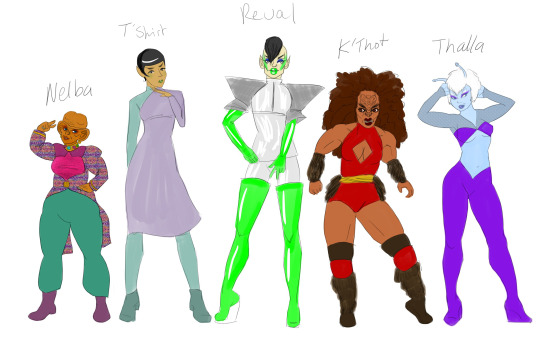
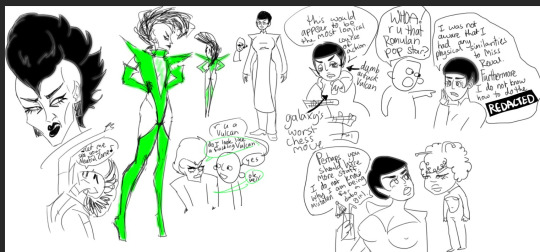
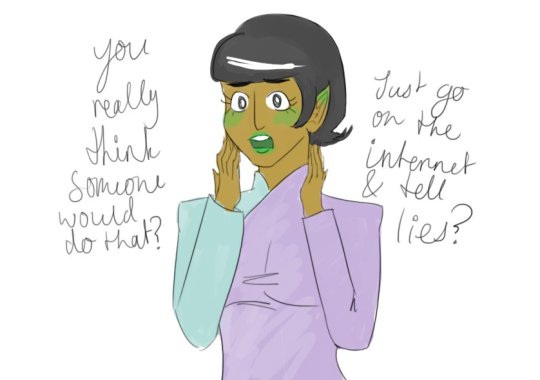

doodling and trying to put together some Actual Lore for my Star Trek cruise ship OCs (Ferengi Girlboss Nelba, Bimbo Vulcan T'Shirt, Romulan Pop Star Reval, Klingon Soap Opera Starlet/Pro Wrestler K'Thot, Angsty Andorian Dabo Girl Thalla, Bored Cardassian Reclaimed Borg 12 of 12)
and by that I mean I am mostly thinking about Reval the Romulan pop star becoming a Federation sensation like peak Lady Gaga and that includes all the backlash too. She's considered the peak of Romulan beauty, tall, broad-shouldered, narrow-hipped and small-chested with sharp, angular features, but has long been ostracised from Romulan society for being Too Lewd and Too Radical. The pose in the first pic is suggestive by human standards but by Romulan standards it's more confrontationally sexual than like Nicki Minaj's Anaconda cover lol. However the post-Dominion alliance with The Federation allowed her to find her niche & her latest album went 2x Latinum on 20 planets. pm the only time homeworlders have approved of her is when she managed to hold an event of Ferenginar (a traditionally patriarchal, misogynistic society) dressed in traditional Romulan (not canon but imo an implicitly matriarchal society) garb + makeup to "empower" Ferengi women. I love her sooo much she's like what if a femboy Lady Gaga was a lesbian girltwink David Bowie. but it was the 80s american hair metal scene. and also if she was from the USSR during the Cold War. and wore latex.
Also like, why would a Vulcan (even a stupid one) be on a Ferengi pleasure cruiser? Well simply Nelba (the cunning fee-male Ferengi captain) saw her in a bikini on Risa with her massive jugs and oblivious nature and saw all the potential customers flocking around her.
Nelba: well hello there ms vulcan... u know a ticket to board my pleasure cruiser is 2 bars of gold-pressed latinum... but for you id be willing to do a special one-off price of 1 bar... T'Shirt: your generosity is noted. however i find it illogical to assume a vulcan has money. Nelba: u make a fine point ms vulcan… hows abt this instead. i give u free board AND an opportunity to make profit… all u have to do is enjoy urself… as long as u do it where everyone can see u… T'Shirt: hm. i will leave tomorrow evening. provide a contract before then.
the only reason why T'Shirt hasn't gotten like trafficked or anything is because her family is quite powerful and well-known on Vulcan... and her sister had her fitted with a biotracker bc of how often she would get lost and end up playing dom-jot with some Breen or some shit. some may consider the terms of her "employment" under Nelba to be trafficking-adjacent as she is essentially an attraction but she truly is just chilling (Sexily). Vulcans being STRONK keeps her safe but it's in Nelba's best financial interests to keep her safe too so she's Fine lol. like there's lots of leering and suggestiveness going on yeah but most creeps lose interest when they realise they can't embarrass her bc 1) too dumb to realise they're trying to cause her shame 2) she's a Vulcan she doesn't feel shame anyway 3) it is illogical to feel ashamed of Being Hot. she's not a hooker (those are aboard, she's just not one) but she is dtf if you don't turn her off. she likes bars but doesn't drink. she provides oo-mox whenever Nelba wants and often just reflexively to Ferengi guests. suffice to say Nelba made her money back and then some lol
fwiw Nelba's cruise ship is largely geared towards fee-males but men are allowed on board, the majority of them just happen to be drag queens, pet twinks of lesbian couples or 24/7 total power exchange type submissives LOOOOOOOOLLLLLLLLLLL it's just that she's a Ferengi Fee-Male Making Profit And Wearing Clothes so basically a superradical spacefeminist and also a lesbian lol so most events, activities and shops aboard are geared towards women with males being an afterthought in a total reverse of Ferengi culture
examples being: Reval the Romulan pop star (aggressively punkishly sexy androgynous openly lesbian, heavily matriarchal but that's just Romulan nature not affected like Nelba's feminism) K'Thot who is literally a soap opera star. like what if on Dynasty Krystle and Alexis shoot fought. what if WWE was real but still also scripted. you get it. maybe you don't but I do Thalla is just a dabo girl but she's of the sort that is going to appeal more to lesbians (less smiley chirpy Customer Service Voice more Sexily Annoyed At You For Even Asking) and Dozen is just a curiosity but Nelba wasn't going to turn down a ?reclaimed? Borg (Dozen is reclaimed in the sense that she has been separated successfully from the hivemind but Cardassians saw no need in removing her implants the way Federation surgeons would so she still looks entirely Borg. especially as she was grey to start lol)
more to come. invite your OCs to the cruise idk
#Star Trek#trekposting#that is going to be my new Star Trek shitpost tag. ummm I will go back and tag previous ones later. look at my aliens
4 notes
·
View notes
Text

Confession #132
"Mirror universe had a Klingon-Cardassian alliance so I think a Klingon-Cardassian arranged marriage fic would be fun to read."
#you guys cannot throw me a shot like this one and expect me not to take it#btw if anybody has any arranged marriage mirror universe garaworf fic to recommend I'm *Pike voice* all ears#confession 132#star-trek-fandom-confessions#star trek#mirror universe#klingon#cardassians
42 notes
·
View notes
Text
I really don't like the recurring idea that if the Federation and Klingons go to war, the Klingons run roughshod over the Federation and can only be defeated by a deus ex machina.
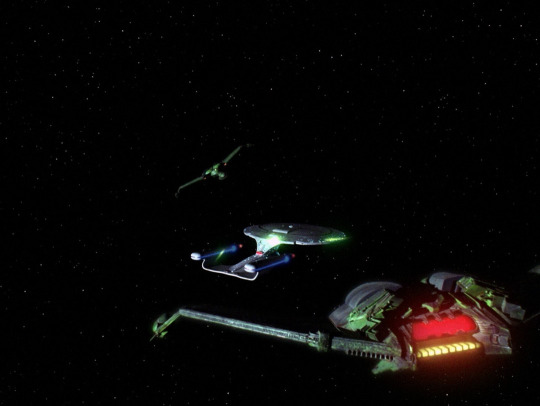
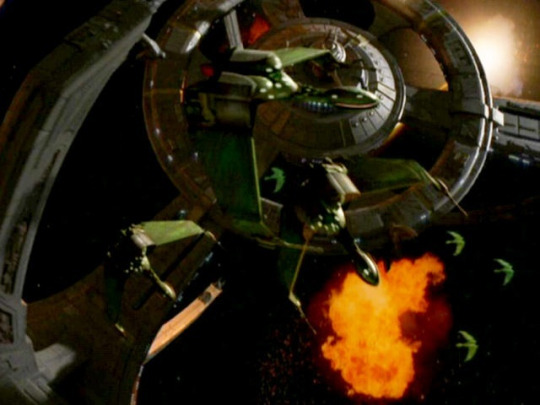
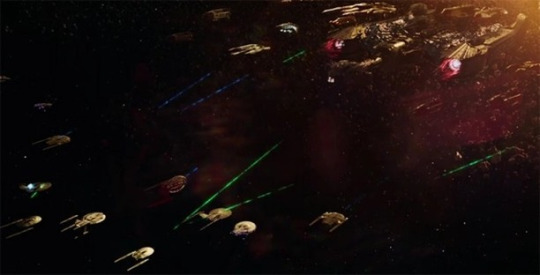
It feels very conservative, very Red Dawn or Edward Gibbon's Decline and Fall of the Roman Empire, that a liberal bureaucratic state is weak and womanly, and will be inevitably dominated by a strong manly warrior race.
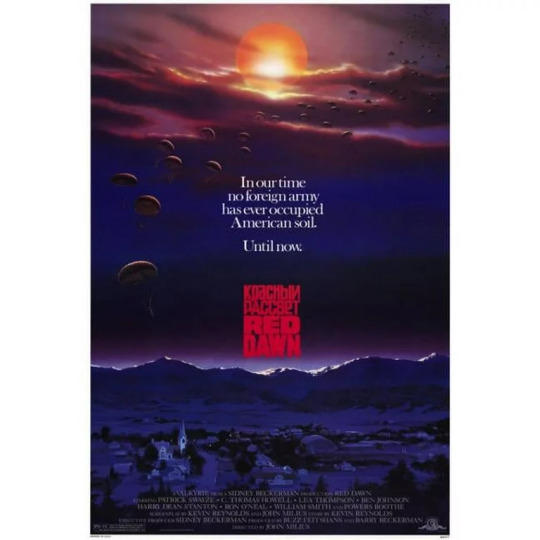

If anything, it'd be more reflective of what we know now about WWII, the Cold War, and after, if Klingon aggression is mostly a bluff.
They know the Federation massively outclasses them in terms of population and industry, and are ruining their own economy dumping everything into the military in the hopes that the Federation doesn't realize it too.
"The Federation says they're all about peaceful coexistence, but what if they're lying? How would we survive?"
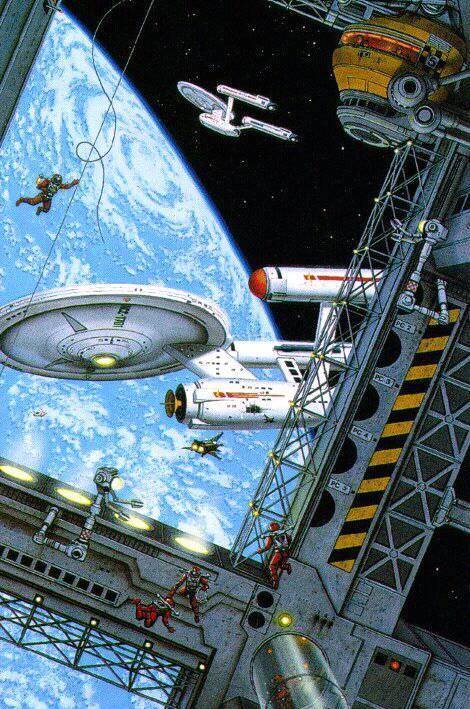
Section 31 was created to explain how how such a pacifist organization as the Federation could survive with hostile empires on all sides. I think it’d be better if it was really just because the UFP is such a diverse alliance, it inherently has more population and industry than the many single-race empires.
If on a full wartime footing, the Federation should probably win simultaneous wars against the Klingons, Romulans, and Cardassians even if just by burying them in starships and soldiers.
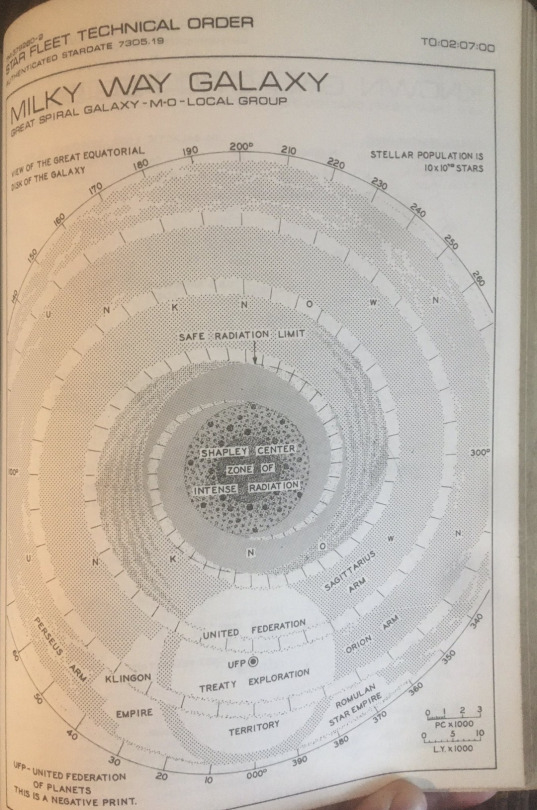
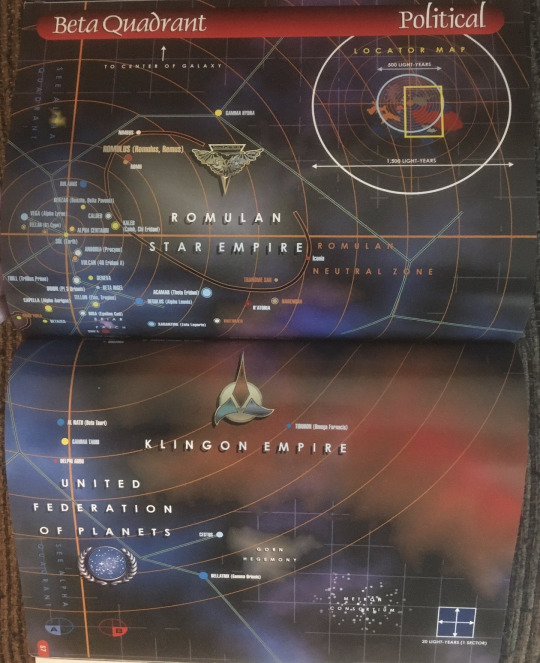
I give Discovery a lot of crap for this, but much as I love DS9 they were really bad about buying into the whole "hard men making hard decisions win wars" idea, both in terms of portraying the Federation as needing the occasional war crime to survive, and in terms of the Terran Empire being overrun by the barbarians after they became more progressive.
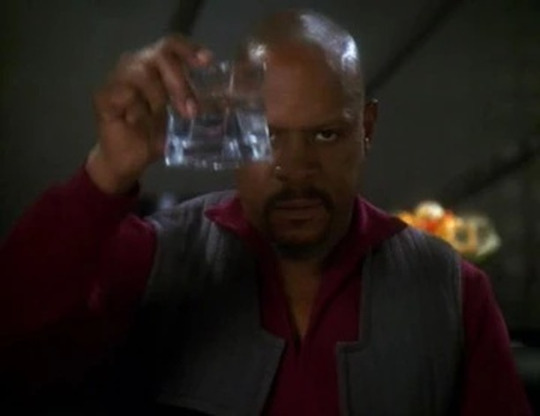
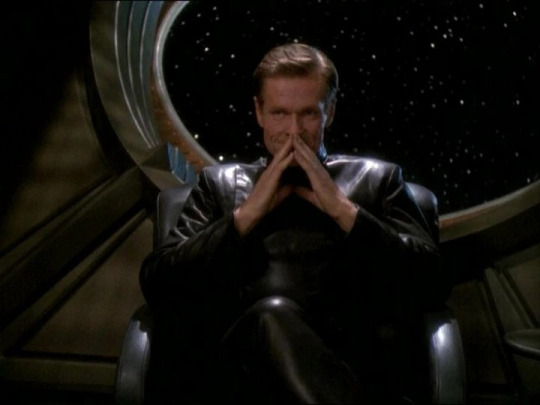

#star trek#politics#economics#war#star trek the next generation#yesterday's enterprise#star trek deep space nine#way of the warrior#star trek discovery#the vulcan hello#battle of the binary stars#cold war#russia#nato#fall of rome#section 31#in the pale moonlight
13 notes
·
View notes
Text
Oh the irony that I only saw DS9 "The Way of the Warrior" after the first two episodes of Discovery.
I could have saved myself lots of angry posts by just pointing out how "The Way of the Warrior" did that kind of story well, and Discovery DID NOT. The parallels between the two plot-wise are also highly suspicious. But that would be me assuming anyone who worked on Discovery had ever watched DS9, and I find that hard to believe.
And as much as I liked "The Way of the Warrior," it itself is the kind of traditional Trek episode I don't even like that much, namely meaningless video game action based on bog-standard in-universe factional disputes. That's okay occasionally, but Trek is a Big Ideas show - shooting bad guys with Space guns is not a big idea.
I did like how much lore was substantially changed, just for this one episode. The Cardassian government has fallen to a coup before the episode even starts, the Klingons unilaterally decide to take advantage of that to rebuild their empire at the cost of any and all long-standing alliances, and Worf shows up in a bad mood and ready to drop out of Starfleet.
Adding him in is like adding salt to a recipe that is already good without it, but just that little extra makes it even better. And his character is consistent with TNG, where he's friendly enough and open to relationships, but he's also very repressed and quick to get annoyed and standoffish. So him dealing with Quark every day now is going to be great fun for both of them!

They did the meet-cute with Jadzia well. They have as much chemistry as Worf is allowed to have with anyone. He's just very quiet and nuanced about showing it.
I like how they mentioned Emperor Kahless. I had forgotten that TNG thing where the Empire was revived under that clone those weird guys made and everyone just went, "Yeah okay sure."
I love Klingons, and it's nice to see DS9 make them something more than the comic relief they were sort of turning into by this point. I don't quite buy that they would be so immediately dead-set on a full-on invasion of Cardassian Space, just blow off Khitomer like it doesn't matter. At least not the whole government. It feels way more like what the Obsidian Order tried that time they thought blitzing the Changeling homeworld was a smart idea, like something only rogue extremists would do. But I'm guessing we get more details about what the Klingons are really dealing with internally going forward.
I also think Gowron backed down waaay too fast, for a guy who seemed 200% down for whatever 5 seconds before. But they had to end this somehow, and he WAS getting his ass kicked by the scrappy border outpost.
...I was so happy to see Gowron again. Bob O'Reilly absolutely digesting the scenery, as usual. This guy has more fun being a Klingon than anyone should be allowed to have.

This has to have one of the highest body counts for this generation of Trek. Between the Klingon and Cardassian fleets, and whatever Cardassian colonies the Klingons stormed, at least a high number of thousands died for this stupid thing. And we see tons of people get shot when Gowron invades the station. I mean, Julian is good, and their weapons were clearly not set to vaporize, but not everyone would have come back from all the meleeing and railing kills.
...Oh and I know they're never going to bring it up, but if the Klingons and Federation actually go to war again, the Organians should totally show up and Q the crap out of both of them. But I know that's like the "don't Klingons have pink blood" thing, they always "forget" about that, just like the whole Klingon forehead thing.
(Because when we DID get into that, it was lame. Fine.)
Seeing Kira and Jadzia being buddies was nice. Kira needs someone like that to get her to relax occasionally. Also, Nana Visitor looks SO MUCH BETTER with that new Kira haircut. It's a subtle change but it's long overdue. Now they just need to get rid of the shoulder pads.

( and I will naturally assume this specific scene has led to slash content. Maybe even some created by women, that isn't terrifying and gross!)
I also really like the scene where Sisko calls Garak in to "measure me for a suit" while they're discussing battle plans, and he immediately figures out what they want and just silently consents. Great character beat.
I don't know what the big deal about the famous "root beer scene" is. Apparently the actors got that reworked into a more meaningful scene than was intended or something? Which I guess was a rare example of that happening in Trek, so good on them. It's a nice little scene and all. But people talk about it like it's some Top Trek Moment and...I mean, they're using root beer as a metaphor for dealing with humans. It's fine. Didn't change my life or anything.
3 notes
·
View notes
Text

Apparently there’s a “fan theory” going around that Star Trek: Discovery is no longer canon after Lower Decks’s finale, and it’s just… really? This is what we’ve been reduced to? It’s the These Are The Voyages discourse again, but with even fewer brain cells. Like something Futurama would come up with to make fun of Star Trek nerds.
According to its purveyors, the theory goes like this: Lower Decks’s finale has a bunch of characters shifting through alternate versions of their ship and themselves thanks to space-time shenanigans, and at one point, some TNG-style Klingons turn into early-Discovery style Klingons. Therefore, not canon!
You might notice that we haven’t even gotten into it yet, but the goal posts have already been moved. By “not canon,” the theory apparently means “from a different timeline than the Lower Decks characters.” Not nearly as provocative, but also, still very silly.
Putting aside that this is clearly a joke about the many times Klingons have been redesigned, that sequence also shows the Cerritos turning into a Sovereign class. Are Sovereigns also not in the Lower Decks timeline? That would be weird considering we’ve seen them before. It’s obvious that some of the transformations we see are from other timelines (like the Terran Empire ship), while others are just different things from the *same* timeline. Not complicated.
It’s also bizarre to use Lower Decks as a canon bludgeon, considering how that show plays fast and loose with the timeline in the name of jokes. In the same episode, we see a Terran Empire version of the Cerritos, which is impossible since according to DS9, the Terran Empire was conquered by a Klingon-Cardassian alliance long before such a ship could have been built. Is DS9 also non-canon now?
Plus, have we already forgotten the time two Lower Decks characters visited Strange New Worlds, a direct spinoff from Discovery? Did the Lower Decks finale make Lower Decks non-canon? Are we stuck in some kind of discourse loop and the only way out is programming Data with the number three?
The reality is as obvious as it is disappointing: this is not a serious theory despite being presented as one. Instead, it is a manifestation of a Trekkie’s most annoying habit. Specifically, the habit of declaring anything they don’t like as “not real Star Trek.”
This is an urge we have to move beyond. Even if we accept that a given piece of Trek is exactly as terrible as its haters claim, nothing is gained from trying to excise it from the franchise. All this does is get people’s hackles up, and it says nothing about whether the Trek in question is *good.*
If you really care about the quality of Star Trek, it’s time to stop playing purity politics with it. That won’t automatically make the discourse helpful and productive, but it will at least be a possibility.
6 notes
·
View notes
Text
Mirror universe headcanon:
Intendant Kira actually hates Gul Dukat too. Kira probably hates Gul Dukat in every universe.
He’s tried to maneuver for a greater Alliance presence on Bajor for years, and Kira has spent the majority of her career making sure that doesn’t happen, reducing Cardassian troops to being limited to Terok Nor, Klingons restricted to only planetside military instillations, appointing Bajorans to planetside administrative positions, including as slave overseers…
She knows what an occupation looks like and that that’s exactly what Dukat is planning. And she is not having it.
Bajor may come second to her ego, but it’s still a high priority.
Her protecting Bajor from being fully bled dry by the Alliance might actually be one of the reasons Garak was always trying to kill her…
And of course, it’s one of the ways she and our Kira have more in common than we think…
#star trek#star trek deep space nine#mirror universe#mirrorverse#klingon cardassian alliance#gul dukat#mirror kira nerys#intendant kira#kira nerys#bajoran#Bajor#elim garak#garak#mirror garak
49 notes
·
View notes
Text
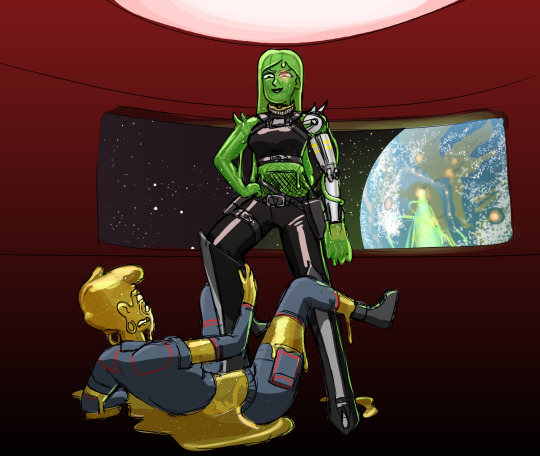
Question: Describe your OCs mirror universe counterpart?
(Mirror Guz, playing an electric accordion.) Hey listen. I'm an engineer. That means I solve problems. Not problems like "what is beauty?" because that would fall within the purview of your conundrums of philosophy. [phaser shots] / [photon torpedoes blasting] I solve practical problems. [horrible raygun sound effects, voices of a human screaming.] For instance: "How am I gonna stop some big mean terran communist from melting me a structurally superfluous new behind?" [electric arc zapping sound, mellanoid resistance fighter gurgling their last breath.] The answer: "use a gun." [clunking sounds of gun reloading; thunder claps; disruptor blasts. A vulcan vaporizes.] And if that doesn't work? Heh. [Subspace field coils energizing. A beam of green light outshines everything else in the view. Within seconds, the planet below is completely destroyed.] Use more gun. >:)
mirror Slamtha and mirror Guz were best friends growing up in the aftermath of the Zaldan-Mellanoid war, a conflict which only ended because the Zaldans were themselves finally conquered by the KCA. Guz and Slamtha were both going to join the United Mellanus Military--Guz would join the engineering corps as a weapons designer; having played too much with leftover explosives as a child for her own good had given her a military scholarship, and Slamtha would be a soldier. When the Mellanoids had reverse-engineered captured Zaldan starships and built their own warp drives, all that did was alert the KCA to their existence. The Klingon-Cardassian Alliance came to subjugate Mellanus. Guz betrayed her people and defected--how else was she to put her talents in the art of weapon design to good use? Slamtha stayed loyal and fought in the resistance. But one day, she was going to find Guz and make her pay.
#Eaurp Guz#Mirror Slamtha#Mirror Guz#Mirror Universe#Star Trek Mirror Universe#Star Trek#Slamtha#Slimegirl#Slimegirls#Villain#Evil slimegirl#cyborg slimegirl#cyborg#cyborg girl
13 notes
·
View notes
Text
Star Trek POP-QUIZ #8
( 25 / 11 / 2023 )
Question 1. Where was Tasha Yar born? a. Adarak Prime b. Turkana IV c. Tarsus II d. Vendikar
Question 2. At what age do Betazoids develop telepathy? a. Generally as toddlers. b. Generally in early adolescence. c. Generally during late adolescence or early adulthood. d. None of the Above, they are born with it.
Bonus Question: Which species can they not read the read the mind of?
Question 3. What is Dr Mccoy's middle name? a. Hubert b. Hester c. Horatio d. Howell
Question 4. TRUE OR FALSE Riker was supposed to be replaced by his doppelganger in the original script of Second Chances ( S6, E24 ).
Bonus Question: What was the name of his doppelganger?
Question 5. When was the Terran Empire dissolved? a. 2267 b. 2361 c. 2189 d. 2293
Bonus Question: What replaced it?
Score: __ /5 + 3 bonus
Question 1. b. Turkana IV
Question 2. b. Generally in early adolescence.
+ Ferengis.
Question 3. c. Horatio
Question 4. TRUE
+ Thomas Riker
Question 5. d. 2293
+ The Terran Republic, however this was quickly overthrown by the Klingon-Cardassian alliance in 2295
#star trek#star trek tos#star trek lower decks#star trek tng#betazoids#dr mccoy#tasha yar#will riker#pop quiz#quizzes#trivia#pop culture#terran empire#mirror universe
2 notes
·
View notes
Text
mirror verses for the trek ladies on this blog:
beverly's mirror verse is a combination of several sources (novels, STO, etc) but she first serves on board of the iss enterprise as chief medical officer. wesley is the result of an affair with pirate jack crusher who was killed shortly after wesley's birth. unlike the events in STO, beverly ends up ascending as emperor of the terran empire instead of wesley - or ends up as president of the imperial federation, depending on the verse.
deanna is part of the iss enterprise crew under picard, but she doesn't respect him - instead, she conspires frequently with riker to dispatch picard in any number of ways. she is security chief on the enterprise therefore third in command, though she keeps her betazed powers hidden because the terrans at this point have wiped out most of her kind. she will kill you and it will hurt the entire time you're dying.
janeway is a rebel leader against the klingon-cardassian alliance with her ship, voyager. when voyager is flung into the delta quadrant, instead of trying to get home she and the crew instead set to use their superior technology to rob/steal/plunder those of the lesser in the quadrant; she's the self proclaimed pirate queen of the delta quadrant. and maybe eventually a borg queen, who knows?
seven's depends on the verse - in one instance, she is entirely human and serving on board voyager. in another instance, she is the independent entity of the borg queen and enacts her will as ordered. (i'm still figuring this one out since she's a relatively new muse).
#( muse && beverly crusher )#( muse && kathryn janeway )#( muse && deanna troi )#( muse && seven of nine )
2 notes
·
View notes
Text
A Toe Upon the Foothold
"Once upon a time, there was a temple in the sky, whose doors opened up to pilgrims who reached for the stars beyond. Like magic, on a scale inconceivable to a worldbound penitent, it gawped wide to welcome travelers, though for a long, dark age, it saw no visitors and made its will ‘known’ through enigmatic blessings in the form of visionary orbs of light.
Then came the Emmissary, who led the children of Bajor to the steps of their temple, and who stood at its gates making demands of the pilgrims: righteous and loud, calling out for justice and equity and diplomacy, for bitter enemies to set aside their tools and weapons and forge peace in the eyes of the Prophets. His message met with mixed results, and his cathedral became a place of itinerant worship, where traders crossed the galaxy through the glittering halls of the Wormhole to mingle with atheists, agnostics, angels, and demons all.
On the Bajoran side, Deep Space Nine guarded the temple gates from exploitation by all comers, and had withstood a cataclysmic war despite its crude origins, and being nestled so close to the badlands where the Prophets coveted their once quiet retreat. It was the best known step of the temple, and for a long time, it was the only encampment on the path.
At the other end of this miracle, however, other pilgrims began to gather when the tide of war ebbed away. Apostates and apostles, outcasts and the forlorn banded together and forged alliances, tenuous but adamant agreements and pacts which allowed their staggered unity to stand up well enough to garner respect from the empires across the sea of stars: though the Federation, the Klingons, the Romulans, and the Cardassians often travelled through with their allies, they were forces who had to stay and lick their wounds after their war with the Dominion, who themselves had retreated into safer space. The barrens around the Gamma Quadrant temple gate were swarming with opportunists, but thinly habitable and sparsely populated, so it was given over to those with no better option to stake their claims and set up a Foothold on the steps beyond…"
--The Fable of the Foothold, subspace drama broadcast by Vedek Durael on the Gamma side of the Wormhole
In the moments before the end of their journey through the Wormhole, the crew of the Vellouwyn gathered at every port and viewscreen aboard, looking out into the inscrutable flow of power which carried them across the stars, mulling their thoughts in silence, or engaging in whatever banter comforted them as they slid through its mysteries. When the brightness broke, clapping almost physically into a state of reality as the dark firmament of space and its blanket of strange stars collapsed into the void where light had swirled moments before, many of the crew took in the far side of the Wormhole for the first time. To them, everything was new, and every question imaginable leapt up to fill wondering minds. To the rest, who had made this journey before during the war, or even on other business, the real surprise was that they were not alone.
Tens and hundreds of thousands of kilometers away from the aperture of the Wormhole, the threshold of power which bid open the Temple Gates when crossed, an amalgam of structures had begun to form in the past several years since the end of the war. Any number of small ships the naked eye could not perceive buzzed like drones between the clusters of larger structures which had begun to form in a constellation around the mouth of the Wormhole. Everything from ramshackle rafts and derelict, lashed-together mounds of metal, to a fantastic sprawling array of interlocking pods that formed a honeycomb mesh of integrated systems which looked paper thin at this distance, drifted in a slowly rotating orbit around some agreed upon point in space somewhere in the middle, marked by a buoy which flashed an invisible subspace beacon to all who ‘docked’ here.
The buoy was mounted on a space station the likes of which had not been seen in over a century in the Beta quadrant: a Suliban Helix, although of a configuration new to most records. It served as a traffic control station for the settlements here, as well as a number of functions of government for those who gathered here, and where Helices of old were brutalist, unsubtle, graceless things, this station had been formed with an artists touch, of interlocking ships which gleamed with reflected light and glowed with sleek running lights. It swept back away from the Wormhole in a corkscrew pattern, trailing branches which bowed out before tapering back in like a spindle.
Interlinked within the cage of the Helix’s far end, habitats honeycombed the space between to form a thriving district of commerce and governance which drew in visitors who had cleared the strict security of the bulbous docking ring. The Inner Helix was foot traffic only, as overlapping layers of encrypted shielding and matter stream suppressors meant that only those graced with an authorization band could transport out of the Helix, and then only to one of the warp-point rail systems at the tail end of the station, where escape pods for high officials could be launched at low warp on outbound trajectories. Otherwise, the only access to the governance center of the Foothold was by strictly managed docking of approved vessels, and entering through customs: the local government did not trust one another, let alone their innumerable detractors out in the galaxy at large, and so took no chances, and bore no shortcuts. All the same, once aboard the station, the atmosphere was pleasant to point of opulence, rich with representations art, culture, history, and law, and featuring an expansive banded-biome habitat menagerie which showcased an array of pleasant plants and animals carefully selected from a plethora of worlds for their benign willingness to pleasantly share space.
While there were living quarters on the Helix, they were carefully concealed from the assaying eyes of the outward observer. Exactly where they were within the compounded cells of meeting rooms, communications salons, cafes, bars, security checkpoints, and milieus which composed the body of the gate checked community of ‘permanent’ residents, the privileged few who were not expected to commute in to work, was a hard kept secret, and it was speculated among many that the inner cells of the hive could be reconfigured like turbolifts, using complex docking algorithms to shuffle entire internal arrangements at need. An attacker could no more pinpoint the sleeping quarters of a council member than they could pick out the kitchens of one of the popular dinettes, making it exceedingly difficult to strategically compromise station security. In the short few years it had been in operation, it had become the envy and the frustration of many on either side of the Wormhole, and served as a monument to the evolution and ingenuity of the once ascendant, now nearly extinct Suliban race.
As coms crackled into existence when the wormhole’s aperture collapsed, clearing subspace of its interference, Ensign Toru Sato took stock of the array of inbound signals, reading off the system’s interpretations of most based on their carrier identifiers, and taking a moment to listen in or view some of the others. Tapping a ready light on his console, he waited for acknowledgement by the captain, who politely requested his report. “Mostly advertisements, sir, and relay traffic for flight control. There are a number of unencrypted personal lines, very little of apparent interest from what I dropped in on, and there seem to be a few low band radio stations broadcasting music, or something like it. We have a welcome line from the Helix, inviting us to prepare a docking boat to board and register, although regs say that’s just a courtesy for Federation ships, so I don’t suspect they really mean for us to acknowledge them.” He offered, dismissively, earning a dubious, scrutinizing look from Durok which put him ill at ease. He swallowed, uncertain of himself suddenly, and finished his report with a tentative: “Sir?”
Durok rolled his eyes slightly, showing mild disappointment in the young ensign. “Mister Sato, we are in our neighbor’s yard, and they have courteously offered us hospitality. I am not sure what you see when you look out there, but this is not our space, and whether we acknowledge the veracity of their claim to it is irrelevant, being as, as they once used to say, possession is nine tenths of the law.”
One or two of the other bridge crew shifted at the admonishment, uncertain as to what to make of it. Some had different culture than what seemed most common for the simian humanoid races of the ‘southern’ galaxy, but the conn officer was already tapping a set of preparatory commands into her console. Durok let her tap away until she finished before speaking to the back of her head, causing her Caitian tail to twitch: “Course of action, ensign Rhee?” he bid with a wry tone of humour in his voice, resting his cheek against his fist and letting his elbow deactivate the status panel on the armrest. If she’d been able to, she’d have blushed, but to her credit she didn’t flatten her ears.
“Sir, orders standing by for shuttlebay to receive an away team. I’ve plotted a course set from our current trajectory both to set the Vellouwyn into a sympathetic orbit lane in alignment with other ships on stand by from local sensors, so that we can be out of the flow of traffic, as well as for our shuttle to reach the docking staging area of the Helix depending on its point of departure. Sir.” Her report meeting with silence, Bhutan Rhee sat rigid for a long moment, before deigning to turn slightly in her seat in order to look askance at the captain, who merely smiled charismatic warmth in her general direction, waving his dark nails for her to proceed. She wheeled back to her console, sweeping a palm across the panel to issue the slated orders, and linked her instruction set in to a work order shared across the room to the first officer’s post at the command station. Moments later, the Nova-II class science vessel veered from its idle coast into the system, making way at the locally regulated tenth impulse to meander over into a waiting parking lane.
“Commander Thomas, please assemble a diplomatic party to accompany aboard the Helix. I would like an anthropologist, one of the procurement group, and our infrastructural engineer to accompany me, please; I expect there will be much to see aboard this station worthy of future discussion.” The commander paused a breath, considering the request, her ice-blue eyes fading momentarily as she mentally surveyed the crew roster she had not yet had time to completely familiarize herself with, before nodding curtly.
“Sir. Aye sir. Will you want anyone in particular for security detail?” she asked, understandably naïve of the nature of the crew all around her. It was not yet well known who and why captain Durok had chosen for this mission, but given the chance to learn, the redundancy of the question would eventually come to light. Durok simply smiled at this, satisfied at the surprises which awaited his newly cobbled family-to-be, and uncrossed his leg to stand up from the chair. “No, I think not Commander. Wouldn’t do to overwhelm our poor hosts on our first visit after all. We four will be more than sufficient. While we’re gone, though, if you’d be so kind as to unseal the dossier on our mission’s special assignment parameters, and start familiarizing the crew with our uniform codes and special equipment outfitting policies, it would be best for the inevitable array of questions I’ll have to answer when I get back.”
As he passed by Thomas’ station on the way to the dorsal corridor at the aft of the bridge, he laid a hand firmly on her shoulder, full of confident familiarity. “Care for this ship, Commander. I leave her to your watch.”
The bridge crew watched him leave with a mixture of puzzled, uncomfortable, and pointedly indifferent expressions, each interpreting his odd presence with the same mixture of discomfort and interest. This was not a Starfleet captain to whom they had been given over to command, and he didn’t behave at all like they’d come to expect from their XOs on previous assignments. Most on the Vellouwyn were young, from a generation which hadn’t seen the wild diplomacy of the Enterprise expansion of Federation borders first hand, and for them this was an assignment to the frontiers of a galaxy which had offered an unprecedented passage to a strange new adventure. Even the older or more experienced among them weren’t hardened veterans: this was, after all, a science ship, and the crew had been chosen for their curiosity as well as their adaptability.
What would become apparent as Commander Paine Thomas pulled up and used her command codes to unseal their special orders dossier, beginning to pick her way through its provisions as her brow furrowed deeper in baffled, quizzical wonder, was that the crew had been hand picked for more than just their scientific worth and taste for adventure. Captain Durok had not selected a security escort because there was, in fact, no security team aboard the Vellouwyn at all. Paine pulled up the personnel files on the three team members she’d picked and issued orders to when the Captain stepped from the bridge, and in skimming through their dossiers, realized they would serve just as well together as if she’d picked a full security team to accompany a man whose prowess she’d come to learn verged, itself, on the supernatural. A low Welsh whisper under her breath drifted to the crew nearby, who heard it as a lyrically accented epithet of surprise, though not disappointment.
As an afterthought, she assigned their shuttle specialist to actually fly the small craft between the Helix dock and the Vellouwyn’s shuttle bay. Flicking their profile on screen, she had no doubt that their ship would be not be molested unchallenged while the captain was otherwise engaged. Simply by way of the sample set, she was certain that getting to know the crew manifest was going to be an exercise in martial academia that would keep her busy for weeks, if not months, just getting to know the nuances of what this crew could fight, and with what tools they might be ready to fight it with.
Whatever else it might be, the Vellouwyn’s scientific mission would not be a defenseless one. What she didn’t yet know was whether the assembly of combat experts serving aboard would have the discipline to get along, or if their new captain expected things to run like one of those dark Imperial ships, with cut-throats climbing the command chain.
Then again… She straightened her back, looking out the view screen, imagining the challenges of the unknown they were about to face in what was certain to be a hostile territory, full of secrets, traps, and bitter locals unprepared to welcome their colonizing neighbors. Perhaps a little fighting spirit would go a long way in what they were out here to do. Time would tell, and the Commander made a pulling gesture from the command console to the secure padd at its edge, tearing it from the Velcro fastener on the back to take with her. The pointers of the files she’d had open switched their encryption hosting from one device to the other, decompiling the information behind it into a randomly hashed negative array of unrecoverable data. She tapped a couple buttons, summoning a junior officer to the bridge to assume her station, and set down in the command chair to start her reading.
This would most certainly be an interesting venture.
3 notes
·
View notes
Text
I had some thoughts on my Star Trek ocs and a new plot for them.
So, it would be a TNG au where after the events of Unification, some stuff goes very wrong with the unification movement and a war breaks out between Romulus and Vulcan (and by extension the Federation). Essentially, the Romulans captured Spock and used the fact he was there as an excuse to attack, claiming he was a terrorist, and this also gained them an alliance with the Cardassians. The Vulcan Isolationists are also involved in all this as they use this whole situation as an example as to why they should hate other species, and maybe some of them are helping out the Romulans in an effort to make a deal with them which won’t go wrong at all, definitely not.
This is where my ocs come into things.
Seren is a half vulcan, half human who was adopted by klingons after the death of his parents when he was 14 (honestly he’s kind of the reverse of Worf lol). He’s an archeologist/anthropologist (he does a mix of both really) and specialises in ancient Vulcan history and Romulans, and he’s very knowledgeable. This gets him a job on the Enterprise, and turns out to be helpful once the war kicks off, especially since he knows quite a bit about the Vulcan isolationists due to family ties. While he isn’t close to that side of his family (his mum got disowned for marrying a human, it’s a whole thing), Seren did contact that side of his fanily at one point, and did a lot of research on the movement afterwards. Overall, what he lacks in social skills he makes up for in knowledge.
Akoli is Seren’s adopted brother and is a klingon. He loves his brother dearly and is very protective of him. Seren’s parents were on a research mission in Klingon space with Akoli’s parents being there to help protect them as it was on the Romulan border, and they were attacked, most of the crew having been killed. When they discovered Seren was left an orphan with no family who wanted him, they adopted him and Akoli gained a brother. Seren didn’t exactly fit in well on Qo’noS, and Akoli saw it as his job to protect his new kind of weak brother, and is worked. In return, Seren helped Akoli study to be an engineer, and even when Seren joined Starfleet they stayed close. Once war broke out though, Akoli hated the thought of Seren being out there in danger and managed to get a job on the Enterprise, where he could keep an eye on his brother. Seren is actually very happy to have Akoli around again since he hasn’t exactly done well in making new friends, other than Liyo, an orion medical officer.
Anyway, that’s the rough idea. I litterally came up with this like an hour ago so there’s still stuff to figure out, I just wanted to talk about it lol.
0 notes